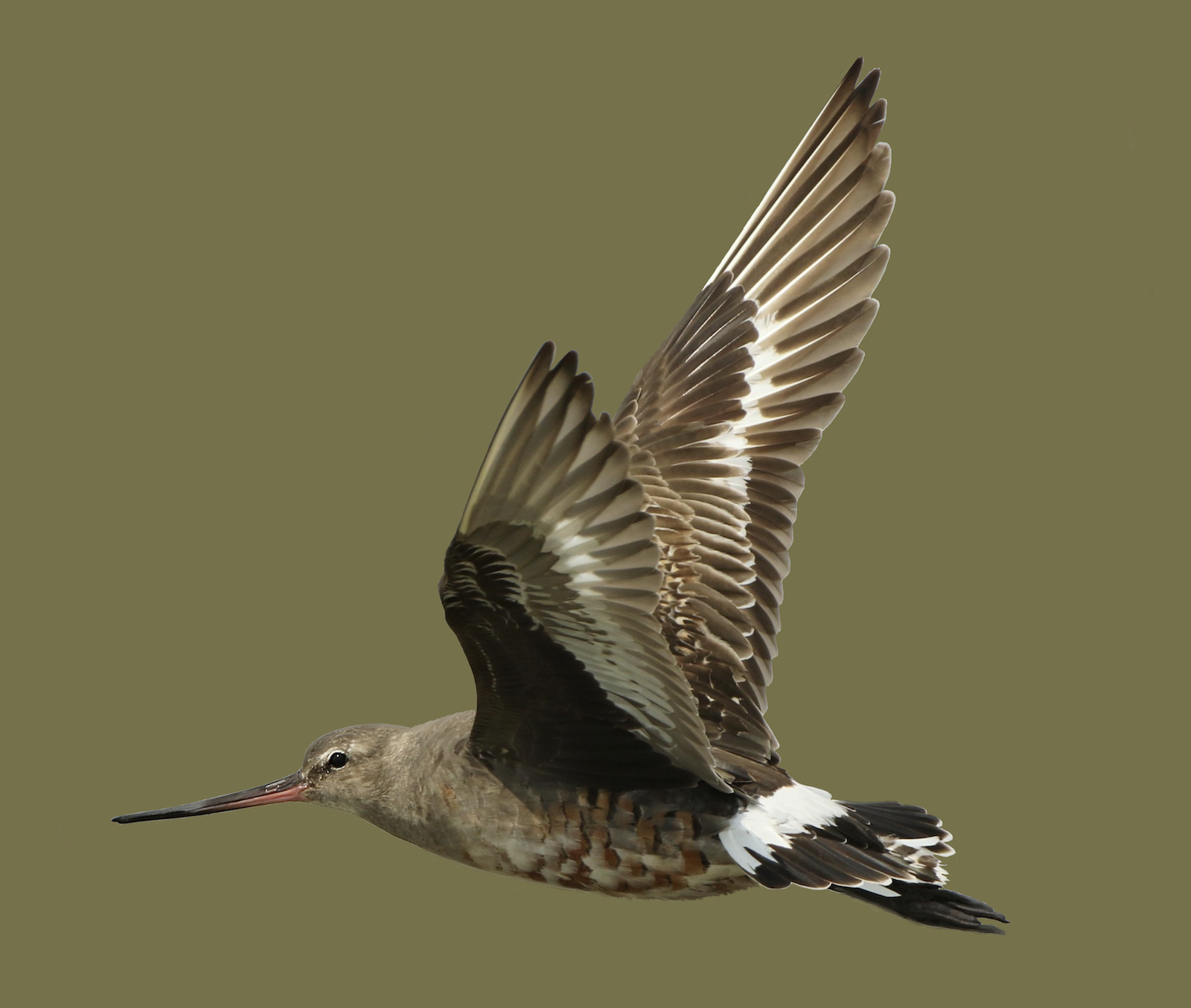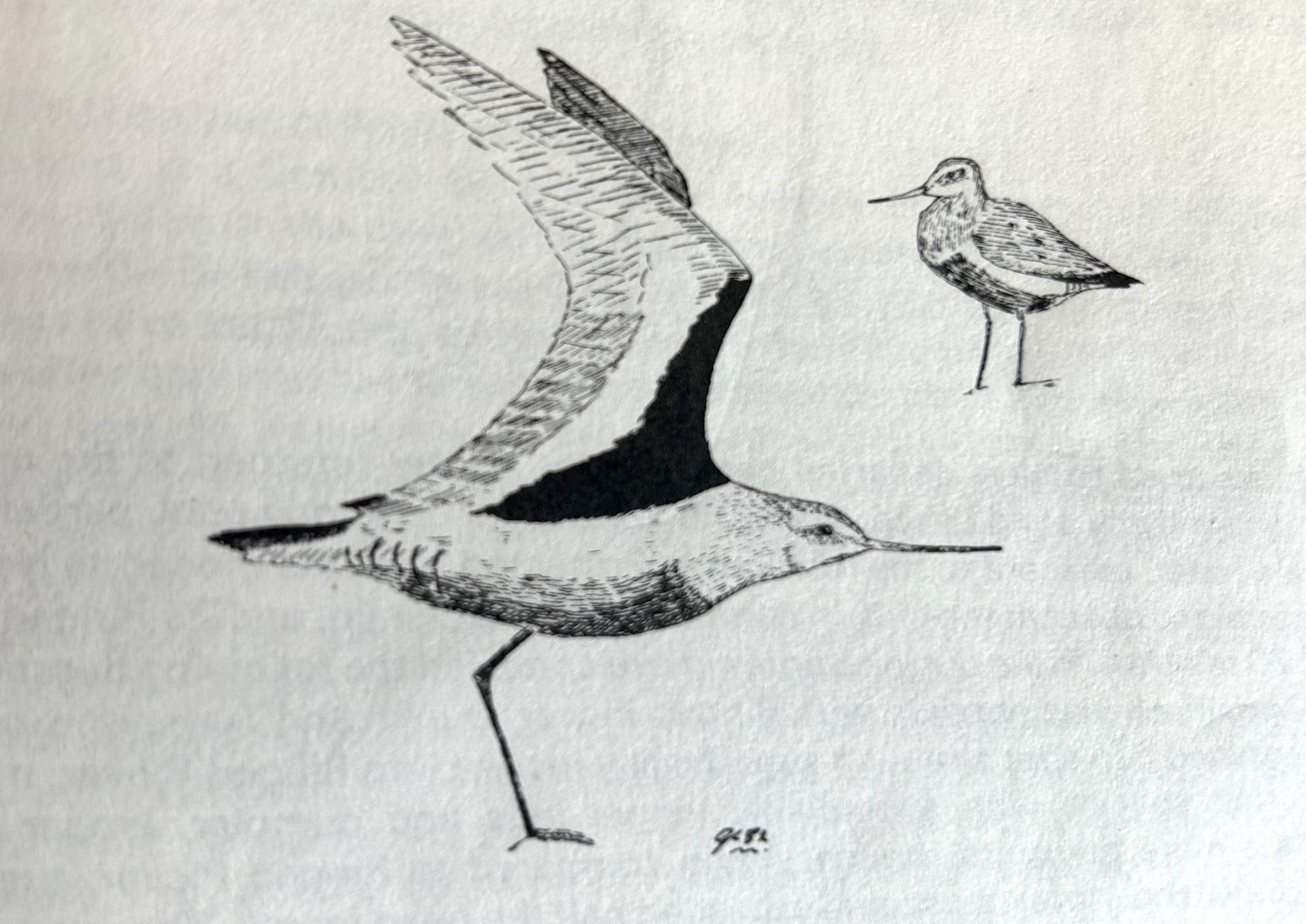Hudsonian Godwit Limosa haemastica
Vagrant. North America.

Computer-generated image courtesy of Colin R Casey.
The Hudsonian Godwit, known in the past as the Ring-tailed Marlin or Goose-bird, old folk names, is the least well known of the world's 4 godwit species. One was found at Blacktoft Sands, Yorkshire, in September 1981 which was a first for Britain and the Western Palaearctic. It visited Alkborough Flats for one day on September 15th, 1981 and remains the sole county record. It returned to Blacktoft where it stayed until October 3rd, last seen flying off to the east. It or another turned up in Devon seven weeks later, from November 22nd, 1981 to January 14th, 1982 at least, and what was assumed to be the same bird turned up again at Blacktoft in 1983.
There have only been two British further records, one in 1988 and much later in April-May 2015. Given the huge flocks of Icelandic Black-tailed Godwits, L.l. islandica, regularly occurring on The Wash these days, assiduous observation of these may be the best chance of locating another in the county.
| Site | First date | Last date | Count | Notes |
| Alkborough Flats | 15/09/1981 | - | 1 | 2CY+ |
Finder’s report: Hudsonian Godwit at Alkborough Flats, September 15th, 1981, first county record.
by G. P. Catley
Note: This account is based on the Finder’s Report published in the Lincolnshire Bird Report, 1981. This bird was a first for Britain as well as Lincolnshire and the RC report for 1981 noted that as this species undertakes a long offshore migration in autumn from northern Canada to South America, it is surprising that it has not been recorded here before. There was debate as to how many birds were involved in 1981, together with one back at Blacktoft April 26th to May 6th, 1983. Despite much perusal of Black-tailed Godwit flocks in the county and elsewhere in Britain, there has only been three other Hudsonian Godwits after the 1981 and 1983 bird: Collieston, NE Scotland, September 26th, 1988; Somerset, April 24th-May 3rd, 2015; Eden Estuary, Fife, November 3rd-December 17th, 2020 (up to the 2021 BBRC report).
Circumstances
On September 15th, 1981, I was searching the fields at Alkborough, South Humberside (sic) for a Buff-breasted Sandpiper which had been feeding there on the previous day. As there was no sign of the bird, I looked on the mud flats where the accompanying flock of Ruff were feeding. On looking over the mud I heard an unusual wader call, a repeated ‘kyow, kyow’. On scanning the mud, I quickly located a lone godwit, the origin of the call. At brief glance it looked like a Bar-tailed Godwit moulting out of summer plumage, but looking rather dark on the mantle. I assumed that it was the unusual ‘Black-tailed Godwit’ which Andrew Grieve had mentioned as being present at Blacktoft Sands the previous day. The bird was, however, so unusual for a Black-tailed Godwit that I took a full description and then attempted to get closer to the bird by creeping around the edge of the saltmarsh. Unfortunately, whilst the bird was out of my view it flew off and I was just in time to see it land on a sandy island in the middle of the Trent. The following is a copy of my description; the flight details were not added until October 3rd when it was at Blacktoft.
Description
General – in size, shape and jizz the Godwit resembled a Bar-tailed, with shortish legs and large amounts of reddish colour on the underparts.
Head - ear coverts greyish-buff, pale supercilium over eye. Crown and nape grey-brown.
Upperparts – mantle and wings brown with a greyish cast and odd gold-tipped, black-centred feathers, remnants of summer plumage on the mantle. Primaries darker, blackish-brown.
Underparts - Chin creamy, throat, upper neck, and upper breast greyish-buff. Centre of belly and lower breast deep russet-red extending in a narrow line to the tips of the undertail coverts. Sides of flanks white with black bars down flanks at the rear and on the sides of the undertail coverts.
Bare parts – bill shorter than Black-tailed, slightly upturned, dark brown with a flesh-coloured base. Legs shorter than Black-tailed and a dark blackish colour.
Flight pattern, October 3rd (at Blacktoft Sands) –dark blackish flight feathers showed a narrow white wing bar shorter than Black-tailed. Mantle brown, lower back very dark brown contrasting with narrow white uppertail band, narrower than on Black-tailed. Underwing pattern unmistakeable: whole of underwing dusky greyish but for pale whitish bar in centre and jet black axillaries and lesser wing coverts.
Addendum
Reference to my available literature on the evening of 15th tentatively suggested a likeness to Hudsonian Godwit, a Nearctic long-distance migrant, but the species is rare in the Nearctic and has never been reported in the Western Palaearctic, so the odds were not in its favour. Further reference to Prater et al (Shorebirds. An identification guide to the waders of the world) briefly mentioned the eastern race of Black-tailed Godwit, which it says is smaller than the western races and has more red on the upperparts in summer plumage. The main distinguishing features of Hudsonian – the flight pattern and more especially the underwing pattern – were not noted until October 1st when the bird was again at Blacktoft, and its final identification was not confirmed until this date. On October 3rd it flew out from Blacktoft in an easterly direction over Trent Falls and out of sight and was not seen again in the area. What was presumably the same bird was relocated in Devon in mi-November 1981.

Sketches of the Hudsonian Godwit, September-October 1981 from the original article in the LBR 1981 (Graham Catley)
References
Catley, G. (undated) Hudsonian Godwit at Alkborough, 15th September 1981. Lincolnshire Bird Report 1981: pp. 35-36.
Grieve, A. (1987) Hudsonian Godwit: new to the Western Palearctic. British Birds 80: 466-473.
(Account as per new Birds of Lincolnshire (2021), included September 2022)

